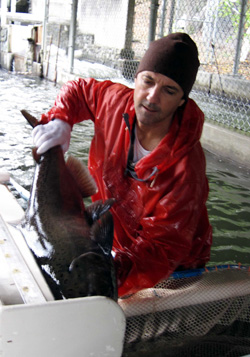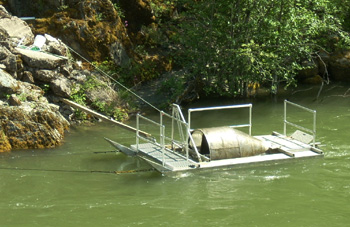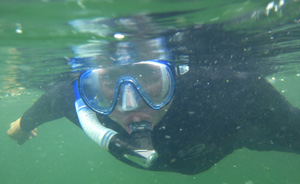Bibliography Background About KRIS
Methods Used to Study Salmon and Steelhead Populations
Fisheries scientists use several methods to collect data on anadromous salmonid populations. The most coveted data are adult population trends but that type of information is expensive to collect and, therefore, is often lacking. Scientists also collect data on salmon and steelhead juveniles that is useful in determining population status. The following are the most commonly applied methods for sampling salmon and steelhead.
 Weir/Dam Counts: Adult salmon and steelhead can most easily be counted at weirs which completely span streams. The migration of adults is blocked and fish are allowed passage through some point or are trapped and passed upstream. The latter allows for collection of scales to determine age or the marking of fish for sampling and population estimation upstream through subsequent creel census or carcass counts. Operation of weirs is very labor intensive and costly and weir counts that yield adult population trends are available for very few rivers or time periods in northwestern California. Weirs are sometimes set up at hatcheries, such as the Noyo River Egg Taking Station, to capture spawners and may also provide adult salmon and steelhead counts. Weirs are also subject to damage during high flows so that even when money is allocated for weir operation, stream conditions can prove confounding. Fish ladders associated with dams, such as Van Arsdale Dam on the Eel River, have, nonetheless, provided long term counts of adult salmon and steelhead.
Weir/Dam Counts: Adult salmon and steelhead can most easily be counted at weirs which completely span streams. The migration of adults is blocked and fish are allowed passage through some point or are trapped and passed upstream. The latter allows for collection of scales to determine age or the marking of fish for sampling and population estimation upstream through subsequent creel census or carcass counts. Operation of weirs is very labor intensive and costly and weir counts that yield adult population trends are available for very few rivers or time periods in northwestern California. Weirs are sometimes set up at hatcheries, such as the Noyo River Egg Taking Station, to capture spawners and may also provide adult salmon and steelhead counts. Weirs are also subject to damage during high flows so that even when money is allocated for weir operation, stream conditions can prove confounding. Fish ladders associated with dams, such as Van Arsdale Dam on the Eel River, have, nonetheless, provided long term counts of adult salmon and steelhead.
Carcass and Redd Surveys: Chinook and coho salmon die after spawning so their carcasses can be counted as an indicator of abundance. Dead fish are marked and subsequent counts make note of how many previously marked fish are sighted. The ratio of marked fish to un-marked fish allows for a population estimate using statistics. Salmon and steelhead nests, called redds, can be seen as depressions in the stream bottom and are counted to help estimate population size. Redd surveys can be difficult or impossible, due to high turbidity, during high flows where watershed conditions are disturbed.
Creel Census: If a significant portion of an adult salmon or steelhead population can be captured and marked with tags or fin clips, the subsequent take in sport fisheries can sometimes be used to estimate the adult population returning to a basin. This sampling regime also allows the angler catch to be assessed.
 Downstream Migrant Trapping: Downstream migrant traps are often operated on small streams where the entire juvenile salmon and steelhead population may be intercepted for a certain period. Larger traps, such as rotary screw traps, operated on larger rivers only capture a portion of migrants and must be calibrated for efficiency if they are to be used to estimate populations of downstream migrants. These traps help to establish run timing and size of juvenile salmon and steelhead as well as relative abundance, if not population size. Biologists often count and measure the fish, note the species and weigh a portion of the captured fish. The data provided by downstream migrant trapping is much more indicative of fish community structure than spot samples such as electrofishing.
Downstream Migrant Trapping: Downstream migrant traps are often operated on small streams where the entire juvenile salmon and steelhead population may be intercepted for a certain period. Larger traps, such as rotary screw traps, operated on larger rivers only capture a portion of migrants and must be calibrated for efficiency if they are to be used to estimate populations of downstream migrants. These traps help to establish run timing and size of juvenile salmon and steelhead as well as relative abundance, if not population size. Biologists often count and measure the fish, note the species and weigh a portion of the captured fish. The data provided by downstream migrant trapping is much more indicative of fish community structure than spot samples such as electrofishing.
 Direct Observation by Diving: Fishery scientists often use masks and snorkels to identify fish under water and to count juvenile or adult fish during low flow conditions in summer. Adult spring chinook and summer steelhead are counted using this method. Hankin and Reeves (1988) set forth a technique of quantifying juvenile salmonids in conjunction with habitat typing which allows basinwide estimates of juvenile populations. This type of survey requires calibration of reaches with electrofishing and basinwide sampling. NMFS has funded coho salmon juvenile presence and absence surveys of northwestern California streams using direct observation (Adams et al., 1996 and Brownell et al.,1999). Pools are sampled and the sampling of a stream ceases when coho are found or ten pools are observed.
Direct Observation by Diving: Fishery scientists often use masks and snorkels to identify fish under water and to count juvenile or adult fish during low flow conditions in summer. Adult spring chinook and summer steelhead are counted using this method. Hankin and Reeves (1988) set forth a technique of quantifying juvenile salmonids in conjunction with habitat typing which allows basinwide estimates of juvenile populations. This type of survey requires calibration of reaches with electrofishing and basinwide sampling. NMFS has funded coho salmon juvenile presence and absence surveys of northwestern California streams using direct observation (Adams et al., 1996 and Brownell et al.,1999). Pools are sampled and the sampling of a stream ceases when coho are found or ten pools are observed.
Electrofishing Samples: Electric current can be used to stun juvenile salmonids which are then captured with nets. If block nets are erected, and timed passes made through the blocked off area, then population estimates for index reaches can be calculated. These in turn can be converted to fish per unit area or volume estimates so that standing crops in a particular reach can be compared over various years. This does not, however, yield information that can be extrapolated to assess basin wide population trends. More abbreviated electrofishing samples are often collected as part of habitat typing. These show which juvenile fish are present or absent, thereby giving some indication of fish community structure.
Problems in Implementation of Fish Population Assessment and Study Design
Adult salmon and steelhead return during high flows in winter when it is difficult or even dangerous to access spawning streams. High turbidity associated with increased flows in disturbed watersheds often makes it impossible to conduct effective carcass counts and redd surveys. Funding for most sampling programs is intermittent so consistent counts needed for trend analysis are not captured. Lack of access to private land also contributes to difficulty in assessing fish populations in entire river basins. Index reaches used for counts cannot be taken as representative of entire streams because habitat conditions and spawner density and use may vary. Low density of salmon spawners now make it difficult to justify the expense of surveying as adults may not even be encountered in some years.
Downstream migrant trapping can also be confounded by high flows. Trap data of this type is more useful if spans a series of years yet consistent funding for such efforts is rare. Electrofishing samples indicate relative abundance of different species but may miss species that do not inhabit stream reaches sampled during summer low flow conditions, such as chinook. The presence or absence studies of coho salmon may find coho present in some years but absent in others. This may reflect strong and weak year classes of returning adults, with some year classes virtually absent in some streams (Brown et al., 1994). Therefore, to make a confirmation of coho presence or absence, a stream must be surveyed for three consecutive years. Studies covering this duration are lacking.
New Efforts To Estimate Coho Abundance in Northern California Streams
A cooperative effort has recently been undertaken to begin consistent surveys in the Mad River/Redwood Creek area of northern California (FSP, 2000). The work includes mapping survey results from 50 to 100 miles of stream in ArcView. Overton and McDonald (1998) have advanced a method for estimating juvenile coho salmon populations in northern California and southern Oregon basins. The success of this endeavor, however, relies on a consistent level of funding to gather field data to support such estimates. The Yurok Tribe also recently embarked on coho salmon juvenile estimates of lower Klamath River tributaries.
References
Busby, P.J., T.C.Wainwright, and G.J.Bryant. 1996.. Status Review of West Coast Steelhead from Washington, Oregon and California. NOAA Technical Memorandum NMFS-NWFSC-27. National Marine Fisheries Service. Seattle WA.
Forest Science Project (FSP). 2000. FSP Technical Report: Regional Coho Salmon Abundance Survey. April 2000. Forest Science Project, Arcata, CA.
Hankin, D.G. and G.H. Reeves. 1988. Estimating total fish abundance and total habitat area in in small streams based on visual estimation methods. Canadian Journal of Fisheries and Aquatic Sciences 45: 834-844.
Higgins, P.T., S. Dobush, and D. Fuller. 1992. Factors in Northern California Threatening Stocks with Extinction. Humboldt Chapter of American Fisheries Society. Arcata, CA. 25pp.
Myers, J.M., R.G. Kope, G.J. Bryant, et al. 1998. Status Review of Chinook Salmon from Washington, Idaho, Oregon, and California. U.S. Dept. Commer., NOAA Tech. Memo. NMFS-NWFSC-35, 443 p.
National Marine Fisheries Service (NMFS). 1996. Factors for Decline: A supplement to the Notice of Determination for West Coast Steelhead under the Endangered Species Act. NMFS Protected Species Branch (Portland, OR) and NMFS Protected Species Management Division (Long Beach, CA). 82 pp.
National Oceanic and Atmospheric Administration (NOAA). 1998. Endangered and Threatened Species: Proposed Endangered Status for Two Chinook Salmon ESUs and Proposed Threatened Status for Five Chinook Salmon ESUs; Proposed Redefinition, Threatened Status, and Revision of Critical Habitat for One Chinook Salmon ESU; Proposed Designation of Chinook Salmon Critical Habitat in California, Oregon, Washington, Idaho. National Marine Fisheries Service (NMFS), NOAA, Commerce. Federal Register/Vol. 63, No. 45/Monday, March 9, 1998/Proposed Rules. 40 pp.
Overton, S.W. and T.L. McDonald. (1998). Regional Estimation of Juvenile Coho Abundance in Streams. Western EcoSystems Technology, Inc. Cheyenne, WY. West Technical Report #98-5
Rieman, B. 1993. Consideration of Extinction Risks for Salmonids. As FHR Currents # 14. US Forest Service, Region 5. Eureka, CA. 12 pp.
